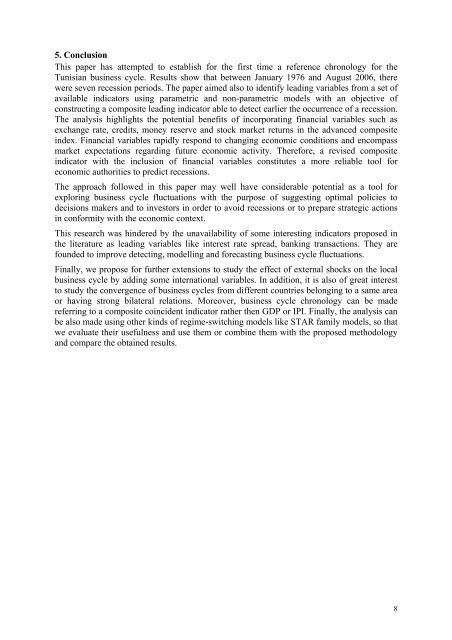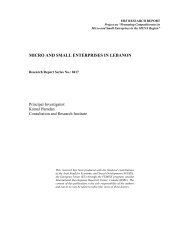compare series in term of lead and lag relative to <strong>the</strong> reference starting and ending recessions,we find also an important number of false signals or missed recession.We tested time distance between series with <strong>the</strong> help of <strong>the</strong> “Banarji test”. Testing Resultsconfirm <strong>the</strong> obtained time distance. In fact, five financial series were <strong>leading</strong> with asignificance rate higher than 95% (see Table 3).4.3 Parametric Selection of <strong>the</strong> candidate variablesIn this section, we consider <strong>the</strong> parametric selection and we estimate separately <strong>for</strong> eachvariable an univariate Markov switching model with two regimes 2 . We calculate <strong>the</strong>durations of expansions and recessions respectively as 1− p 22and 1− p 11and we excludeseries with too short or too long phases of recession. We use Smoo<strong>the</strong>d probabilities toidentify recession and expansion dates: a month is considered to be in recession when <strong>the</strong>inferred probability is greater than 0.5, and a period of recession must last at least sixconsecutive months.Quadratic Probability Scores (QPS) are reported in Table 4 and show that BVMT","EURTND", "RESERVE", "CRDCT", "Avoirex", "Engagex", "CONCMT" and "MM2"present a considerable lead lasting from four to nine months.There<strong>for</strong>e, we confirm again that, in general, monetary and financial variables are able todetect earlier economic downturns.At <strong>the</strong> end of this selection exercise, We validate six <strong>leading</strong> series from <strong>the</strong> two selectionexercises which are : “Avoirex” (outside assets), “Engagex”(outside commitments), “RDCT”(short term credit), “ONCMT”(medium term financing of <strong>the</strong> <strong>economy</strong>), “reserve” and“MM2” (monetary supply M2). We excluded <strong>the</strong> BVMT series because its sample is shortcompared to o<strong>the</strong>r series since it starts in 1998 and so, it will limit our investigation sample toseven years instead of twenty two years.In Figure 4, we plot <strong>the</strong> selected <strong>leading</strong> <strong>indicators</strong> toge<strong>the</strong>r with <strong>the</strong> reference chronology.We remark clearly <strong>the</strong> advance of <strong>the</strong> financial <strong>indicators</strong> since <strong>the</strong> shaded areacorresponding to <strong>the</strong> reference recessions always follows <strong>the</strong> dates of slowdowns indicated byfiltered probability bigger than 0.5. We notice particularly that <strong>the</strong> 1987's, 1992's, 2001's and2004's recessions are detected with an advance of at least four months.4.4 The Composite <strong>leading</strong> IndicatorIn <strong>the</strong> above section, we founded that a large number of monetary and financial variableshave a time lead of at least three months. This enabled us to construct a composite <strong>leading</strong>indicator that exploits a vast and complex array of in<strong>for</strong>mation on <strong>the</strong> Tunisian <strong>economy</strong>.More importantly, because <strong>the</strong> <strong>leading</strong> variables, in any given period, contain in<strong>for</strong>mation on<strong>the</strong> same common shocks that will hit <strong>the</strong> <strong>business</strong> <strong>cycle</strong> only later.We report in Table 5 <strong>the</strong> parameters estimation from <strong>the</strong> MSVAR model and we plot inFigure 5 <strong>the</strong> recession periods detected with <strong>the</strong> new composite <strong>leading</strong> indicator.Once again, financial variables, even being combined toge<strong>the</strong>r, succeed to detect earlier <strong>the</strong><strong>business</strong> <strong>cycle</strong> turning points. In addition, we state that <strong>the</strong> number of false signal decreaseconsiderably. Thus, considering co-movement helps a lot in signalling correct in<strong>for</strong>mation.112 Estimation is done using Gauss program and <strong>the</strong> MSVARLib2.0 package written by Bellone, 20057
5. ConclusionThis paper has attempted to establish <strong>for</strong> <strong>the</strong> first time a reference chronology <strong>for</strong> <strong>the</strong>Tunisian <strong>business</strong> <strong>cycle</strong>. Results show that between January 1976 and August 2006, <strong>the</strong>rewere seven recession periods. The paper aimed also to identify <strong>leading</strong> variables from a set ofavailable <strong>indicators</strong> using parametric and non-parametric models with an objective ofconstructing a composite <strong>leading</strong> indicator able to detect earlier <strong>the</strong> occurrence of a recession.The analysis highlights <strong>the</strong> potential benefits of incorporating financial variables such asexchange rate, credits, money reserve and stock market returns in <strong>the</strong> advanced compositeindex. Financial variables rapidly respond to changing economic conditions and encompassmarket expectations regarding future economic activity. There<strong>for</strong>e, a revised compositeindicator with <strong>the</strong> inclusion of financial variables constitutes a more reliable tool <strong>for</strong>economic authorities to predict recessions.The approach followed in this paper may well have considerable potential as a tool <strong>for</strong>exploring <strong>business</strong> <strong>cycle</strong> fluctuations with <strong>the</strong> purpose of suggesting optimal policies todecisions makers and to investors in order to avoid recessions or to prepare strategic actionsin con<strong>for</strong>mity with <strong>the</strong> economic context.This research was hindered by <strong>the</strong> unavailability of some interesting <strong>indicators</strong> proposed in<strong>the</strong> literature as <strong>leading</strong> variables like interest rate spread, banking transactions. They arefounded to improve detecting, modelling and <strong>for</strong>ecasting <strong>business</strong> <strong>cycle</strong> fluctuations.Finally, we propose <strong>for</strong> fur<strong>the</strong>r extensions to study <strong>the</strong> effect of external shocks on <strong>the</strong> local<strong>business</strong> <strong>cycle</strong> by adding some international variables. In addition, it is also of great interestto study <strong>the</strong> convergence of <strong>business</strong> <strong>cycle</strong>s from different countries belonging to a same areaor having strong bilateral relations. Moreover, <strong>business</strong> <strong>cycle</strong> chronology can be madereferring to a composite coincident indicator ra<strong>the</strong>r <strong>the</strong>n GDP or IPI. Finally, <strong>the</strong> analysis canbe also made using o<strong>the</strong>r kinds of regime-switching models like STAR family models, so thatwe evaluate <strong>the</strong>ir usefulness and use <strong>the</strong>m or combine <strong>the</strong>m with <strong>the</strong> proposed methodologyand compare <strong>the</strong> obtained results.8
















